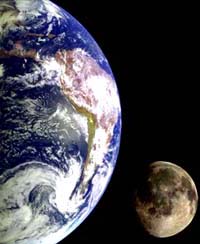| . |  |
. |
 Solving A Wobbly Question Of Oceanic Proportions
Solving A Wobbly Question Of Oceanic ProportionsPasadena - July 17, 2000 - The century old mystery of Earth's "Chandler wobble" has been solved by a scientist at NASA's Jet Propulsion Laboratory in Pasadena, California. The Chandler wobble, named for its 1891 discoverer, Seth Carlo Chandler, Jr., an American businessman turned astronomer, is one of several wobbling motions exhibited by the Earth as it rotates on its axis, much as a top wobbles as it spins. Scientists have been particularly intrigued by the Chandler wobble, since its cause has remained a mystery even though it has been under observation for over a century. Its period is only around 433 days, or just 1.2 years, meaning that it takes that amount of time to complete one wobble. The amplitude of the wobble amounts to about 20 feet at the North Pole. It has been calculated that the Chandler wobble would be damped down, or reduced to zero, in just 68 years, unless some force were constantly acting to reinvigorate it. But what is that force, or excitation mechanism? Over the years, various hypotheses have been put forward, such as atmospheric phenomena, continental water storage (changes in snow cover, river runoff, lake levels, or reservoir capacities), interaction at the boundary of Earth's core and its surrounding mantle, and earthquakes. Writing in the August 1 issue of Geophysical Research Letters, Richard S. Gross of NASA's Jet Propulsion Laboratory reports that the principal cause of the Chandler wobble is fluctuating pressure on the bottom of the ocean, caused by temperature and salinity changes and wind-driven changes in the circulation of the oceans. He determined this by applying numerical models of the oceans, which have only recently become available through the work of other researchers, to data on the Chandler wobble obtained during the years 1985-1995. Gross calculated that two-thirds of the Chandler wobble is caused by ocean-bottom pressure changes and the remaining one-third by fluctuations in atmospheric pressure. He says that the effect of atmospheric winds and ocean currents on the wobble was minor. Gross credits the wide distribution of the data that underlay his calculations to the creation in 1988 of the International Earth Rotation Service, which is based in Paris, France. Through its various bureaus, he writes, IERS enables the kind of interdisciplinary research that led to his solution of the Chandler wobble mystery. Gross's research was supported by NASA's Office of Earth Science. "The excitation of the Chandler wobble," will appear in the journal, Geophysical Research Letters, volume 27, number 15 (August 1, 2000). The author is Richard S. Gross of the Jet Propulsion Laboratory, California Institute of Technology, Pasadena, California.
TERRADAILY.COM
|
| |||||||||
| The content herein, unless otherwise known to be public domain, are Copyright 1995-2016 - Space Media Network. All websites are published in Australia and are solely subject to Australian law and governed by Fair Use principals for news reporting and research purposes. AFP, UPI and IANS news wire stories are copyright Agence France-Presse, United Press International and Indo-Asia News Service. ESA news reports are copyright European Space Agency. All NASA sourced material is public domain. Additional copyrights may apply in whole or part to other bona fide parties. Advertising does not imply endorsement, agreement or approval of any opinions, statements or information provided by Space Media Network on any Web page published or hosted by Space Media Network. Privacy Statement All images and articles appearing on Space Media Network have been edited or digitally altered in some way. Any requests to remove copyright material will be acted upon in a timely and appropriate manner. Any attempt to extort money from Space Media Network will be ignored and reported to Australian Law Enforcement Agencies as a potential case of financial fraud involving the use of a telephonic carriage device or postal service. |